Kinesiology test 2
1/132
There's no tags or description
Looks like no tags are added yet.
Name | Mastery | Learn | Test | Matching | Spaced |
|---|
No study sessions yet.
133 Terms
What is the base for the entire upper body extremity?
shoulder girdle
what is the only attachment of the upper extremity to the axial skeleton
scapula and its attachment through clavicle at sternoclavicular joint
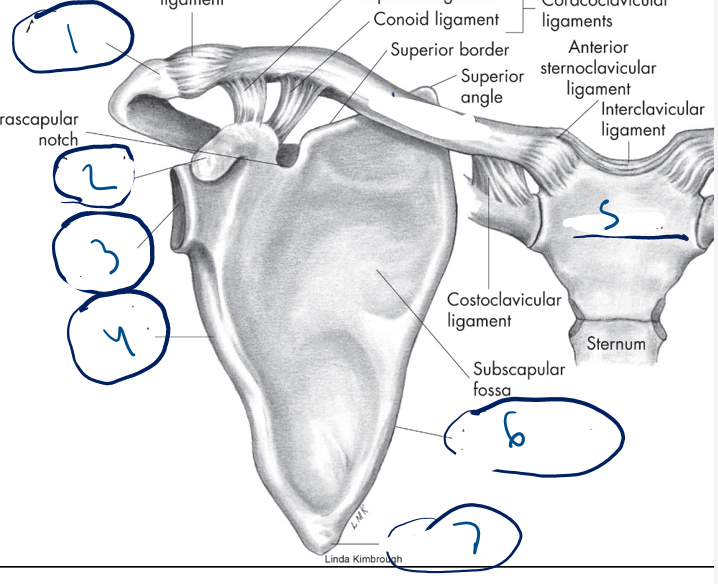
1
acromion process
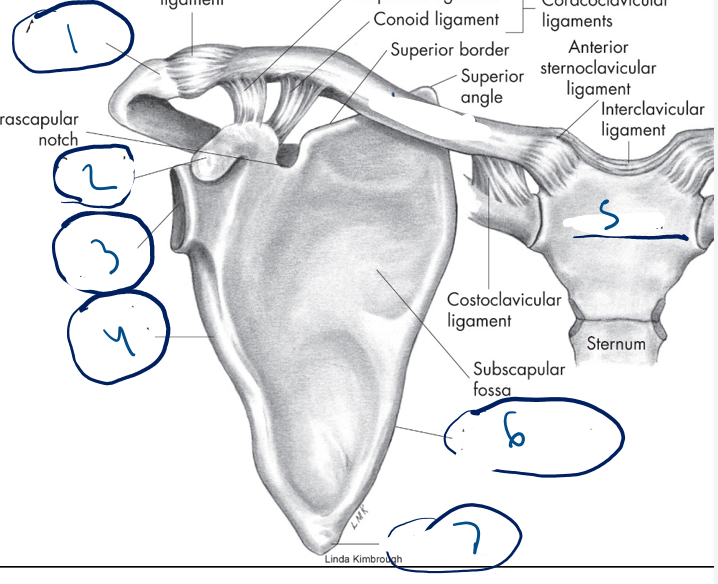
2
coracoid process
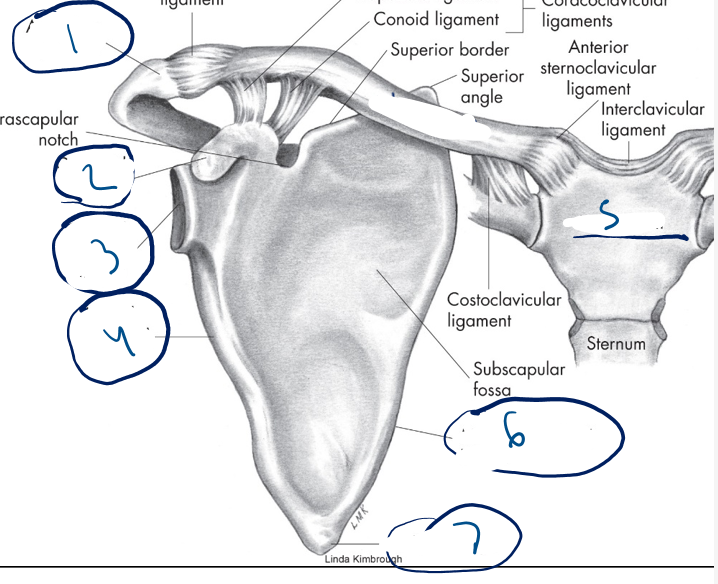
3
gelnoid cavity (fossa)
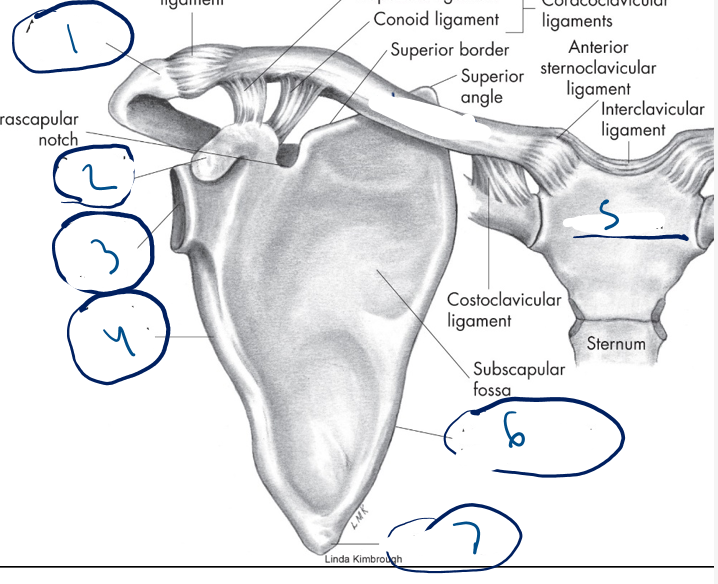
4
lateral (axillary) border
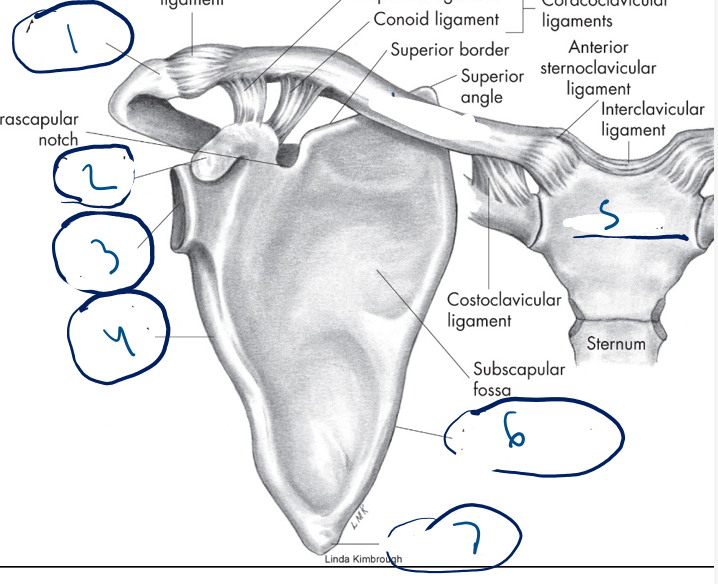
5
manubrium
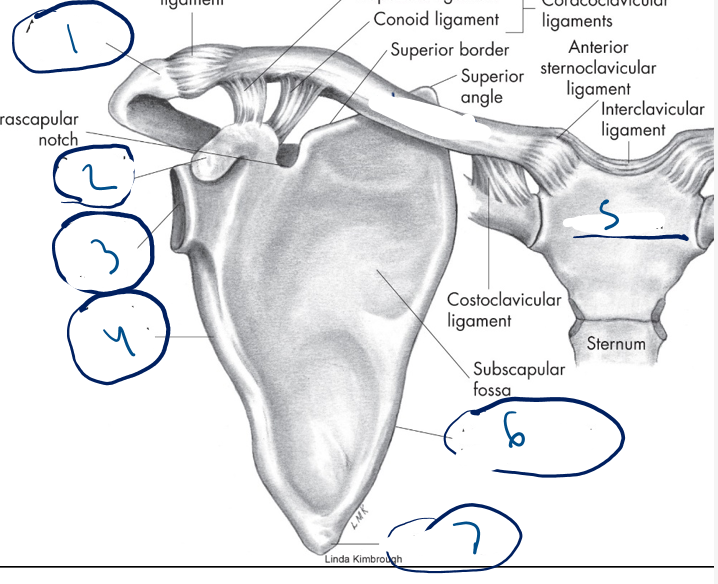
6
medial (vertebral) border
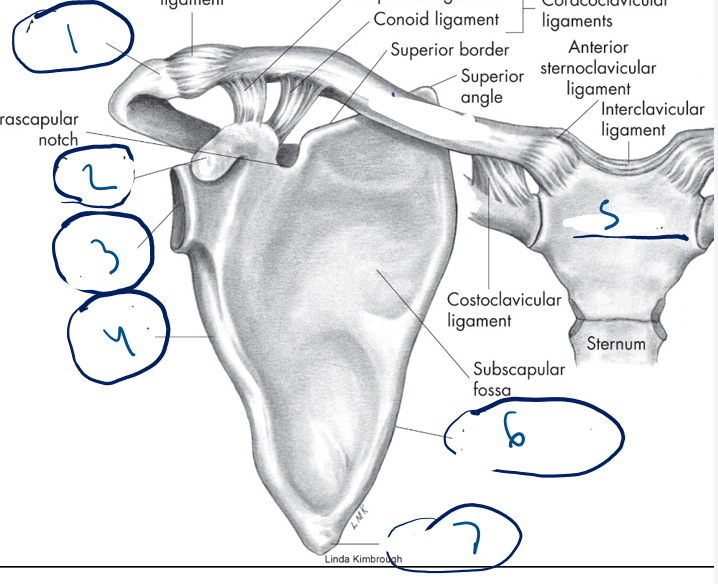
7
inferior angle
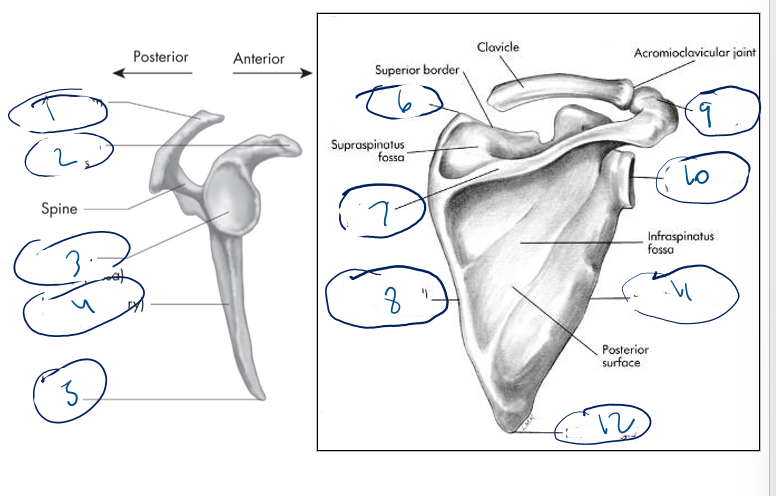
1
acromion process
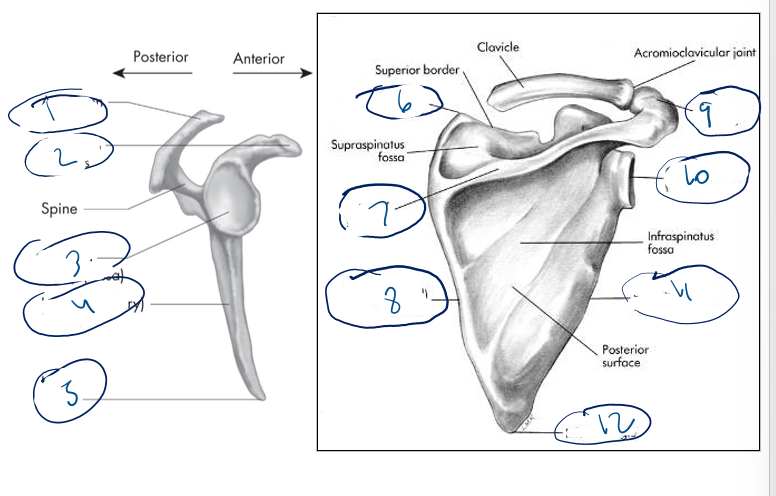
2
coracoid process
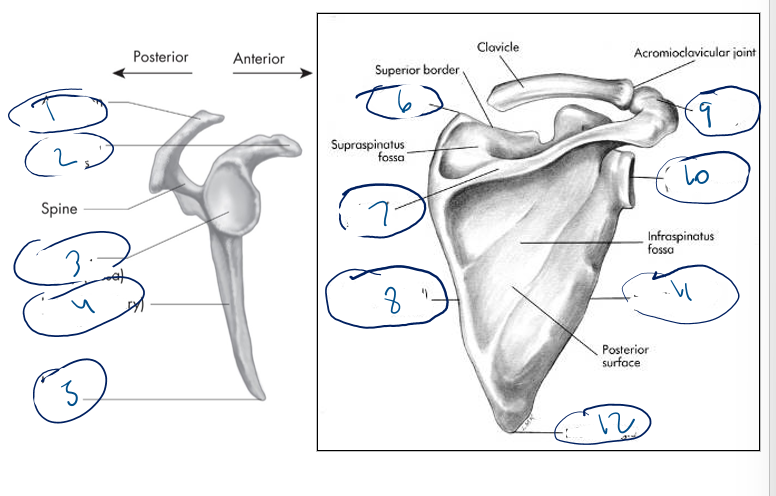
3
glenoid cavity (fossa)
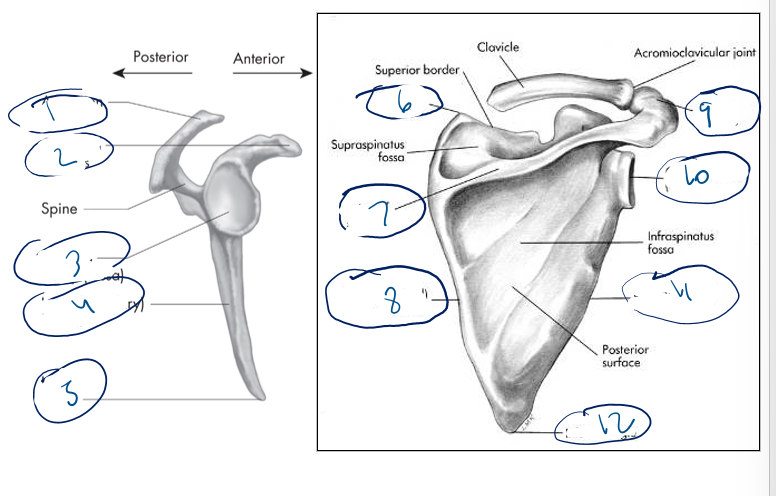
4
lateral (axillary) border
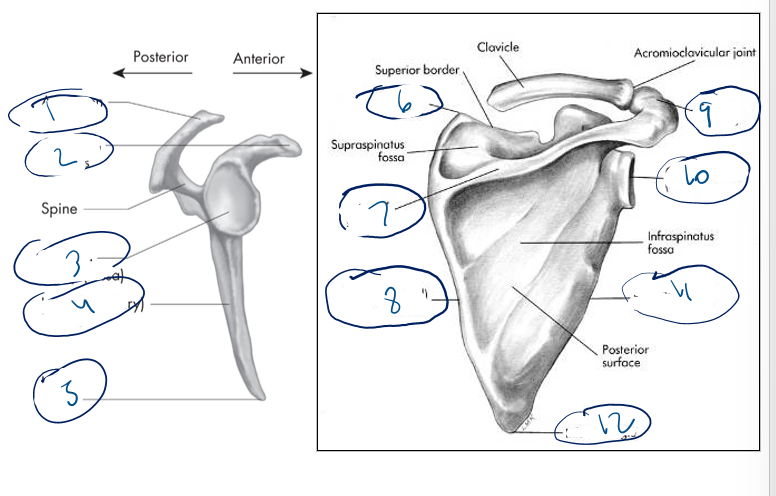
5
inferior angle
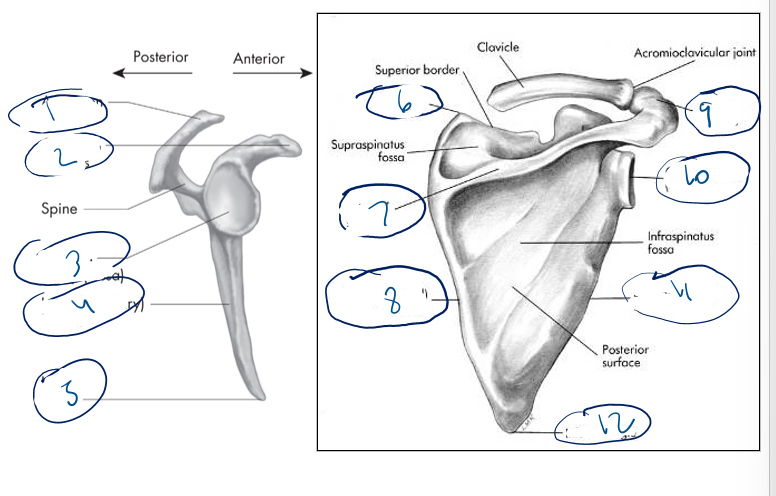
6
superior angle
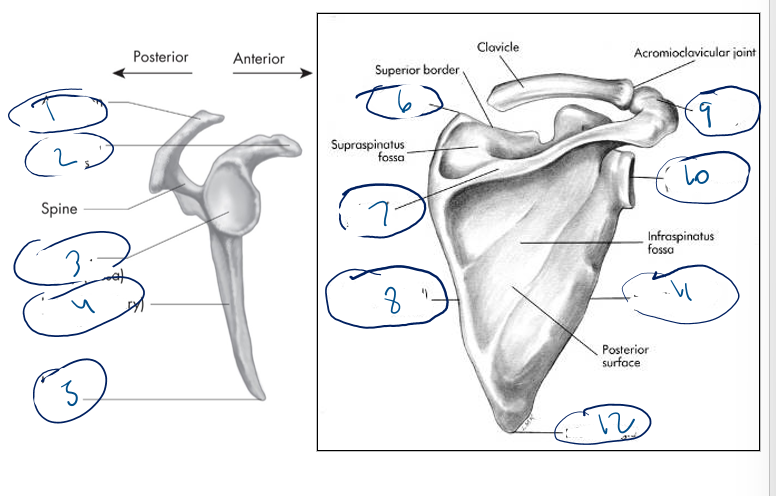
7
spine of scapula
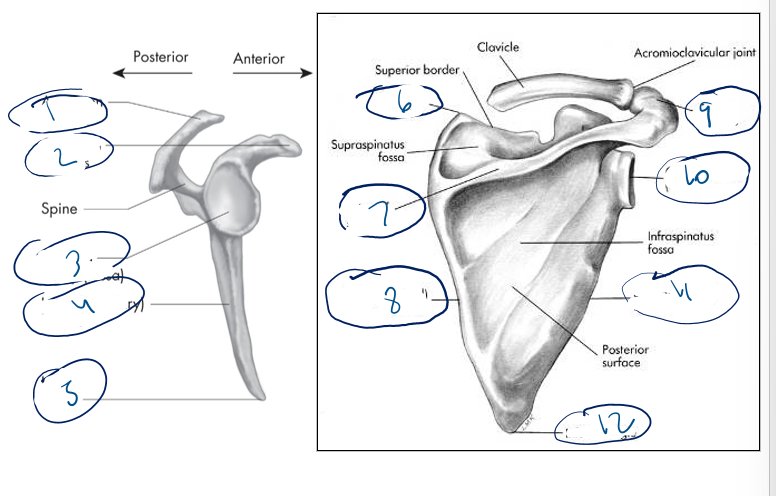
8
medial (vertebral) border
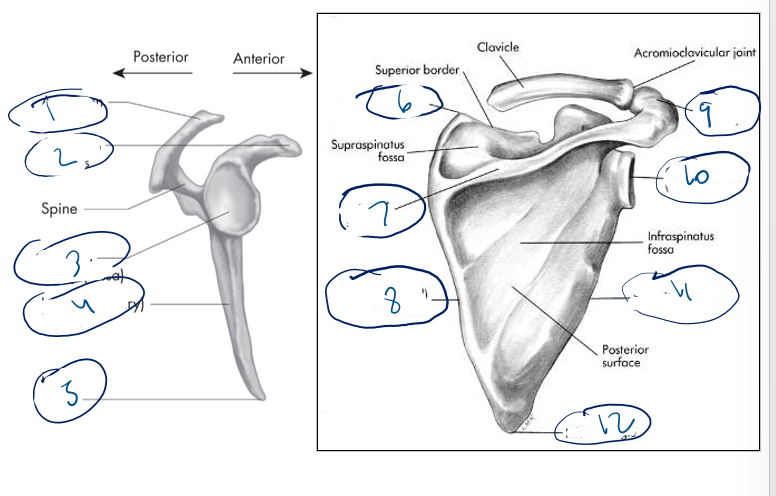
9
acromion process
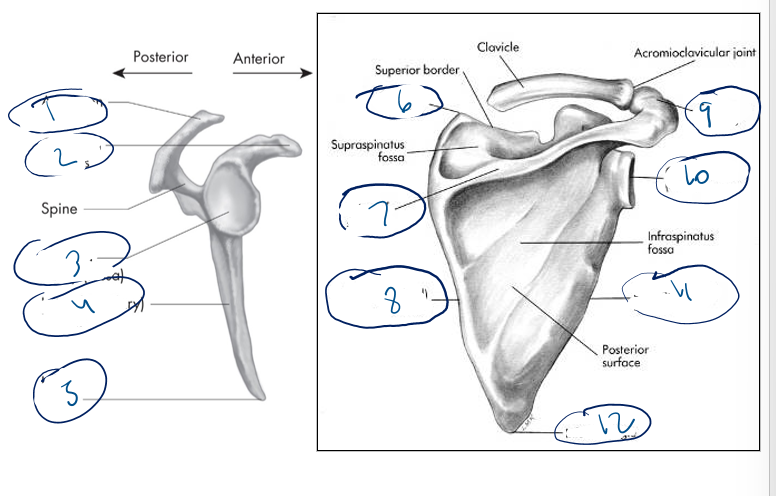
10
glenoid cavity (fossa)
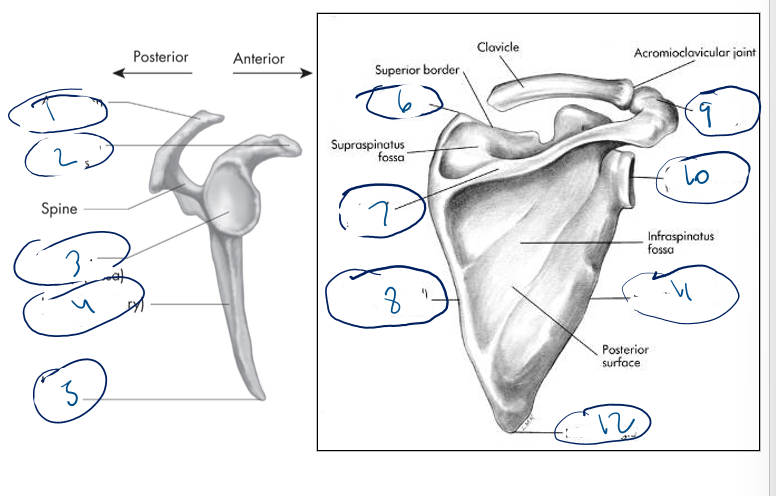
11
lateral (axillary) border
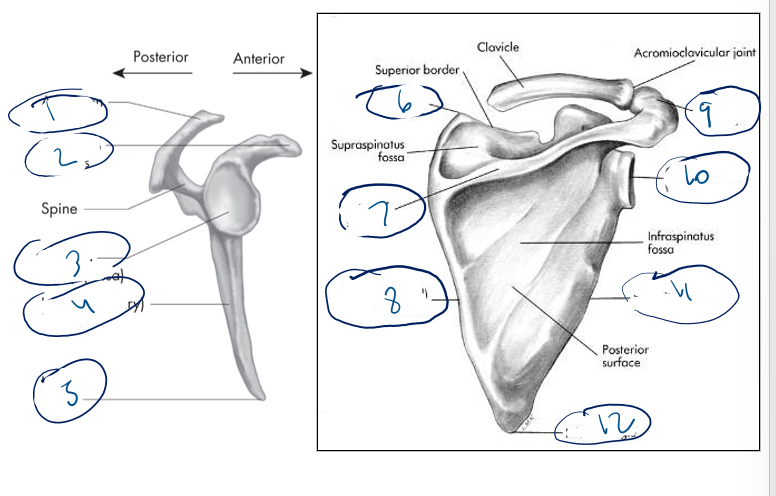
12
inferior angle

1
acromial end

2
sternal end
what does the scapula move on
rib cage
shoulder girdle joint motion occurs on
sternoclavicular joint and to a lesar amount at the acromioclavicular joint
how many axis does sternoclavicular have and classification
multiaxial arthroidal
movements of clavicle in relation to the manubrium
protraction, retraction, elevation, depression, some slight rotary gliding movements
ligamaents of sternoclavicular joint
anteriorly by the anterior SC ligament
Posteriorly by the posterior SC ligament
acromioclavicular joint classifcation
arthroidal
acromioclavicular joint motions
gliding and rotational motion accompanying other shoulder girdle and shoulder joint motions
acromioclavicular joint supported by
coracoclavicular liagament, superior AC ligrament, inferior AC ligament
Is scapulothoracic a true synovial joint
no
what does the scapulothoracic joint depend on to move
SC and AC joints
scapulothoracic joint movements
abduction and adducation, upward and downward roatation, elevation and depression
scapulothoracic joint upported by
its muscles, no ligaments
shoulder girdle muscles functions
◦Stabilize scapula so the shoulder joint muscles will have a stable base from which to exert force for moving the humerus
◦Contract to maintain scapula in a relatively static position during shoulder joint actions
◦Assist with extreme ranges of motion in the shoulder
how far does humerus move without scapula movement
90 degrees
where do the muscles of the shoulder girdle origniate and insert
originate on the axial skeleton and insert in scapula and/or clavicle
muscles of shoulder girdle actions
•Essential in providing dynamic stability of the scapula so it can serve as a relative base of support for shoulder joint activities such as throwing, batting, & blocking
scapula muscles actions
◦Important in spinal posture
◦Important to maintain lumbar lordosis & keep head over trunk in balanced position
◦Good posture enhances easier inspiration
what is upper cross syndrome and what do the muscles do
contributes ti kyphosis (hunchback)
less functional posisition of the glenohumeral joint
inhibited neck flexors, rhomboids, serratus anterior
tight upper trapizus, levator scapula, pectorals
name the 5 primary muscles of the shoulder girdle
trapieius
romboid
levator scapula
serratus anterior
pectoralis minor
seratus anterior orgin, inerstion, action
o: surface of upper 9 ribs
i: anterior aspect of medial border of scaula
a: abduction, upward rotation
helps with pushups, punching, pushing
pectoralis minor orgin, insertion, action
o: anterior surface of ribs 3-5
i: coracoid process
a: abduction, downward rotation, depression
trapezius orgin, insertion, action
o: base of skull → 12th thoracic vertebrae
i: lateral clavicle → acromion process → scapular spine
a: upper fibers: Elevation and extension of the head
Middle fibers: Elevation addiction, and upper rotation
Lowerw fibers: Adduction, depression, upward rotation
Rhomboid orgin, insertion, action
o: Spinous processes of C7-T5
I: Medial border of scapula, below spine
A: Adduction, downward rotation, elevation
Levator scapulae orgin, insertion, action
o: Cervical vertebrae 1-4
I: Medial border from superior angle to spine
A: Elevation
what nerves innervated shoulder girdle muscles and vertebrae its on
Cervical and brachial plexus (C5-8, T1)
Muscles responsible for scapula abduction (protraction)
(push up, bench press)
Pectoralis minor
Serratus anterior
Scapula addiction (retraction) muscles
Middle/lower trapezius
Rhomboids
scapula upward rotation muscles
Middle/lower trapezius
Serratus anterior
(overhead press, throwinging, spiking)
scapula downward rotation muscles
(Lat pull down, pull up)
Pecotralis minor
Rhomboids
scapula elevation muscles
(shoulder shrug)
Levator scapulae
Upper/middle trapezius
Rhomboid
scapula depression muscles
(dip)
Lower trapezius
Pectoralis minor
where is the shoulder joint attached to the axial skeleton
sternoclavicular joint
scapula movement usually occurs with movement of
Humerus
common shoulder joint problems
Rotator cuff impingements
Sublaxations ans dislocations
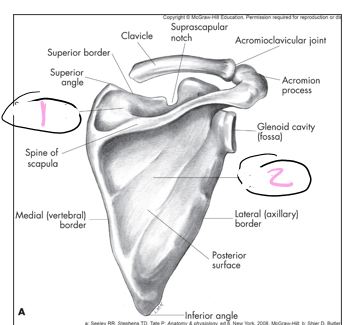
1
Supraspinous fossa
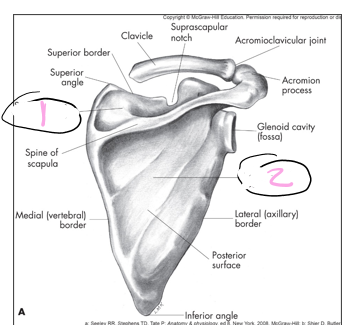
2
infraspinous fossa
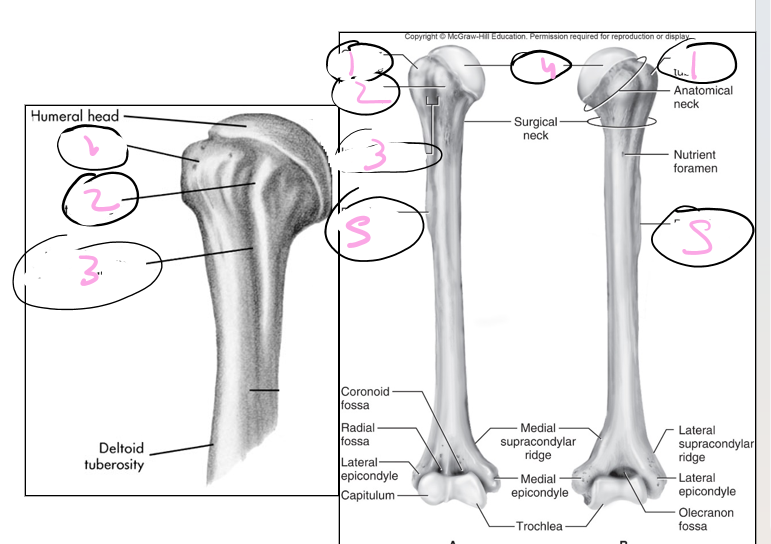
1
Greater tubercle
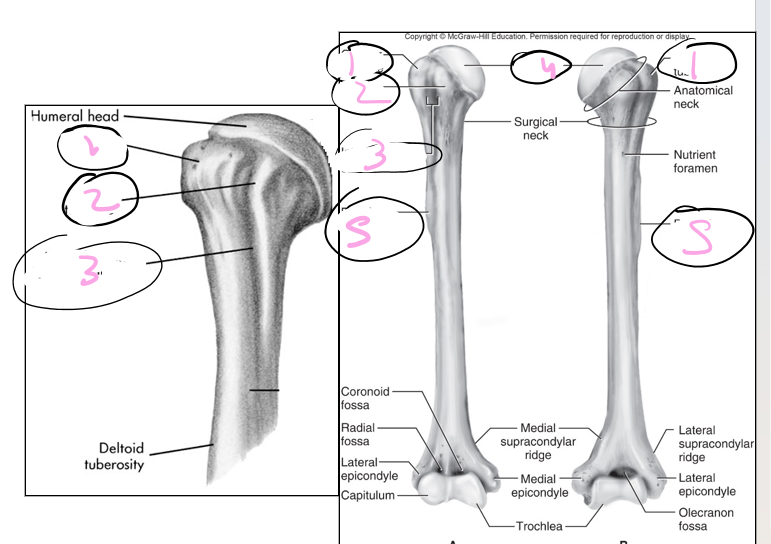
2
lesser tubercle
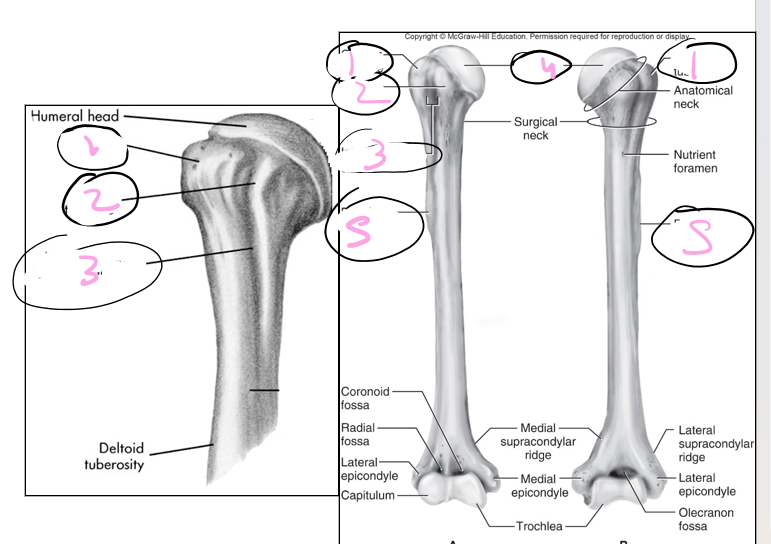
3
intertubecular groove
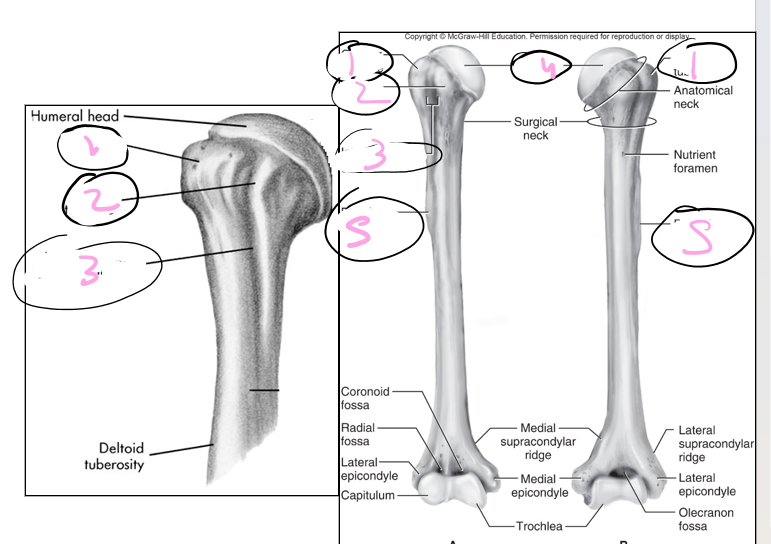
4
head
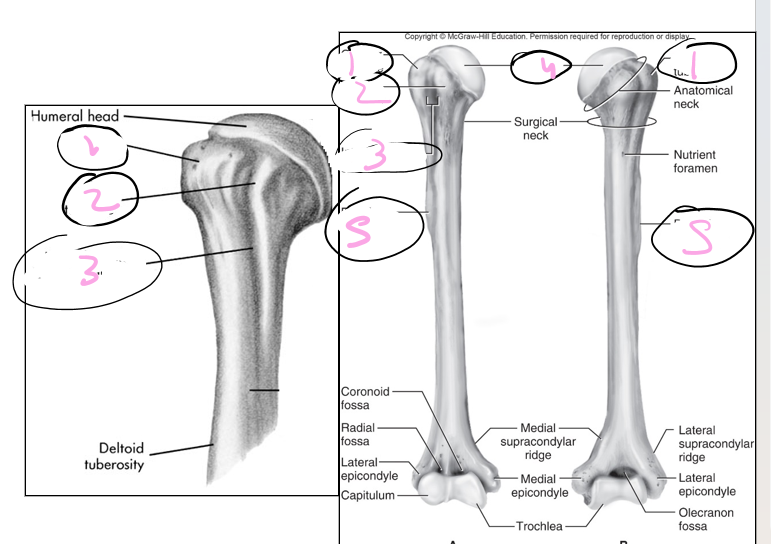
5
deltoid tuberosity
what is the most moveable joint in the body
glenohumeral joint
what kind of joint is the glenohumeral joint
multiaxial ball and socet, moves in all planes
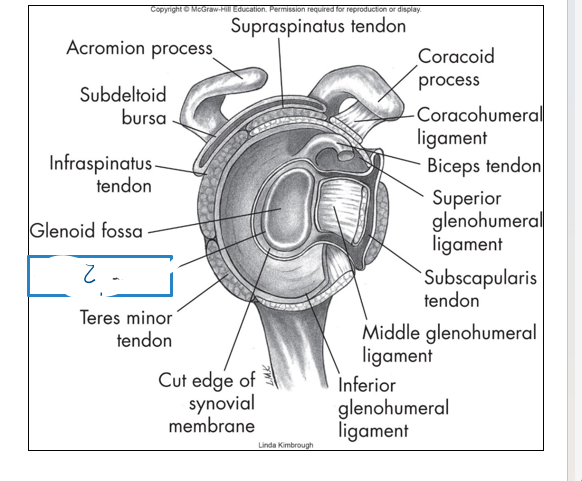
glenoid labrum
how do gelohumeral ligaments provide stability
anterioraly and inferiorly
inferior glenohumueral lighament: anterior/posterior
are glenohumeral ligaments tight or lax
lax to have mobility
what glenohumeral joint disloactions are common
◦anterior or anteroinferior glenohumeral subluxations & dislocations – common – abducted and externally rotated
how common are posterior glenohumeral joint dislocations and instability
rare but instability common
name the rotator cuff muscles
supraspinatus
infraspinatus
teres minior
subscaoularis
where do rotator cuff muscles attach
top, front, and rear of humeral head
rotator cuff muscles function
humeral rotation, •vital in maintaining humeral head in correct approximation within glenoid fossa while more powerful muscles move humerus through its wide range of motion
Shoulder/ GH joint abduction cause shoulder girdle/scapula ____
upward roation
Shoulder/ GH joint adduction cause shoulder girdle/scapula ____
downward rotation
Shoulder/ GH joint flexion cause shoulder girdle/scapula ____
elevation/upward rotation
Shoulder/ GH joint extension cause shoulder girdle/scapula ____
depression/downward rotation
Shoulder/ GH joint internal rotation cause shoulder girdle/scapula ____
abduction (protraction)
Shoulder/ GH joint external rotation cause shoulder girdle/scapula ____
adduction (retraction)
Shoulder/ GH joint horizontal adduction cause shoulder girdle/scapula ____
abdduction (protraction)
Shoulder/ GH joint horizontal abduction cause shoulder girdle/scapula ____
adduction (retraction)
glenohumeral abduction
upward lateral movement of humerus out to the side away from body
glenohumeral adducton
downward movement of humerus medially toward body from abduction
glenohumeral flexion
movement of humerus straight anteriorly
glenohumeral extension
movment of humerus straight posteriolrly
glenohumeral external rotation
movment of humerus laterally around its long axis away from midline
glenohumeral internal rotation
movment of humerus medially around its long axis toward midline
glenohumeral horizontail adduction
movment of humerus in a horizontail or transverse plane toward and acrris the chest
glenohumeral abduction
movement of humerus in a horizontail or transverse plane away from the chest
where do the intrinsic glenohumeral muscles originate
scapula and clavicle
what are the intrinsic glenohumeral muscles
deltoid
coracobrahialis
teres major
roator cuff mucles (subscapularis, supraspinatus, infraspinatus, teres minor)
where do the extrinsic glenohumeral muscles originate and attach
orginate on the tunk attack to the humerus
what are the extrinsic glenohumeral muscles
lattissimus dorsi
pectoralis major
what glenohumeral muscles are anterior
pectoralis major
coracobrachialis
subscapularis
what glenohumeral muscles are superior
deltoid, supraspinatus
what glenohumeral muscles are posterior
lattissimus dorsi
teres major
teres minor
infraspinatus
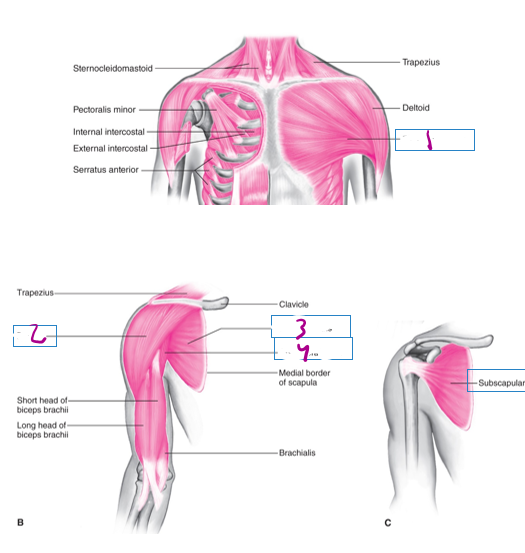
1
pectoralis major
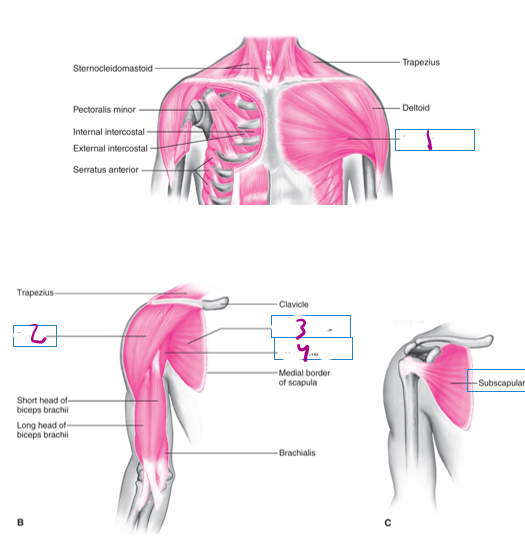
2
deltoid
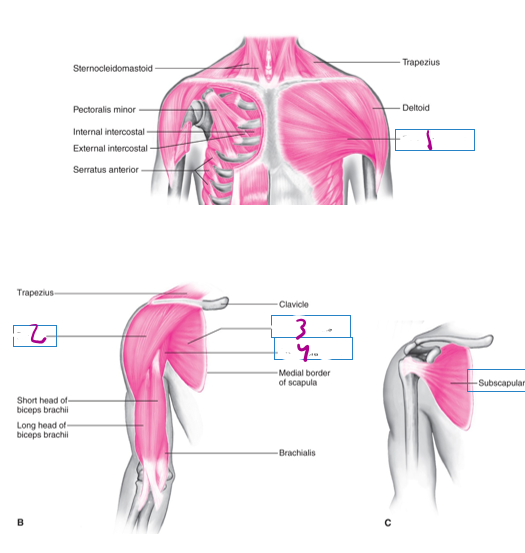
3
subscapularis